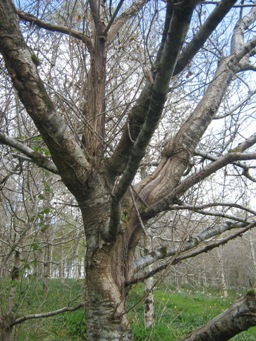The plight of the red squirrel is well known since the introduction of grey squirrels into the wild in 1876. Greys are known to have been introduced to Exeter in 1915 and first found their way into Cornwall in 1951. The last known red squirrel in Cornwall was seen in 1984 so their demise has been very rapid indeed. In southern England they have only survived on Brownsea Island and the Isle of Wight, where active measures have been taken to prevent the arrival of grey squirrels.
Photo: Wildstock
Early attempts to control grey squirrels by paying a bounty for their tails were entirely ineffective and they have become a major bird predator and woodland pest. Recent attempts to protect remaining red squirrel populations have had much more success. On the island of Anglesey in North Wales red squirrels had survived in small numbers in the pine plantations of Newborough Warren. In 1997 the numbers of Reds had declined to as few as 40 individuals, so a campaign to clear grey squirrels from the entire island was started. This has enabled the existing red population to expand and now stands at over 400. Re-introductions have been undertaken in parts of the island and small numbers have now crossed the Menai straights back into Gwynedd.
Grey squirrel control continues on Anglesey as every year a small numbers of greys find their way back over the road and rail bridges. Controlling greys on the Bangor side of the straights is now helping Reds to spread further into Wales.
The next big project is to re-introduce reds to the far west of Cornwall from where they have been extinct for nearly 30 years. Current plans are to try and eradicate grey squirrels in the Penwith and Lizard peninsulas before re-introducing reds to suitable habitat areas. Grey eradication would then continue eastwards through the Cornish peninsula further extending the territory available for reds to re-colonise. For details please visit http://www.cornwallredsquirrels.co.uk/
We still need to know more about improving existing habitats for reds and also how to effectively manage greys on a landscape scale. While grey squirrels are seen as a major pest by most woodland owners, widespread trapping or shooting is far from being universally popular. None of the big wildlife charities have had the courage to support red squirrel projects because of the need to kill the greys. County Wildlife Trusts are taking the line that they do not view it as a ‘priority’ for wildlife conservation at the present time, but I am sure they just don’t want to be seen to be killing anything. Will they allow greys to remain in their nature reserves and to impede the re-colonisation of reds?
Meanwhile landowners, including the Duchy of Cornwall are preparing to co-ordinate the creation of grey-free zones so that reds can be re-introduced.
Even if you are nowhere near a red squirrel area you may wish to consider managing you grey squirrel population. Greys are particularly keen on stripping the bark of fast growing young trees during the spring, so if you have trees (conifer or broadleaved) aged between 5 and 25 years, you should make grey squirrel control a priority. Live trapping remains the preferred method of control of the squirrel projects. Many small woodland owners find daily inspection of traps quite onerous and have found Kania traps to be very effective http://www.kania2000.co.uk/about-the-kania2000.html . If you are not keen on lethal traps you may prefer http://www.victorpest.co.uk/heavy-duty-sonic-pestchaser
 Right: grey squirrel damage to an oak tree. The leading shoot has been killed and lower branches are scarred from bark stripping. Weak branches are then prone to breaking off. A badly damaged wood has been likened to a giant flailed hedge! Sycamore and beech are very prone to damage and oak is also vulnerable. Ash is resistant, but now has other problems with the spread of Ash Dieback Disease.
Right: grey squirrel damage to an oak tree. The leading shoot has been killed and lower branches are scarred from bark stripping. Weak branches are then prone to breaking off. A badly damaged wood has been likened to a giant flailed hedge! Sycamore and beech are very prone to damage and oak is also vulnerable. Ash is resistant, but now has other problems with the spread of Ash Dieback Disease.
Who knows, the Cornwall project may eventually get all the way back to Devon in a few years time, and meanwhile you will get plenty of hazelnuts to enjoy each year.
Simon




